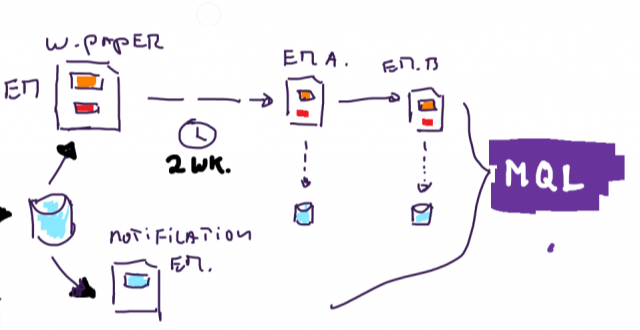Building a B2B website for optimal lead generation
If you run a business in this digital age, you probably have a website. Otherwise, you're a lot less visible to your target audience. What most marketers don't realize, however, is that a website isn't enough anymore. It's not just about online presence anymore. It's about shaping an online presence that allows you to generate leads as effectively as you used to do with your shop window.
For many marketers, a Web site is like a business card. That thinking leads to static websites that don't encourage users to convert online. While that is exactly what your website should do for you. Without this conversion aspect, your business is like a physical store in the middle of nowhere, with no staff. Fine, you have a store. But how do people find it, and what do they do once they get there? Marketers need to start thinking about the customer experience of their Web site and focus on generating leads through the Web site. You can do that by applying these five simple tips.
5 tips toturn your B2Bwebsite intoa marketing machine.
1. Think of your website as a real business site
In the past, a website was nothing more than a digital brochure or business card. You knew you had one, but didn't consider it in the ecosystem of your business. This approach no longer works. Otherwise, you're spending money on keeping a website running that no one wants to (or even can) interact with.
The digital age has caused a shift for audiences in all sectors. People today expect a smooth and effortless online journey to communicate, research and buy products or services. If your company can't provide that, users will simply go to the competition. Even if you offer the best product or service, users will opt for the lower-quality company with a higher-quality online customer experience.
You have to look at your Web site the same way you look at a physical store or a face-to-face meeting with a customer. Your Web site deserves at least as much attention and energy as these traditional channels. That means turning your static, brochure-like website into an online platform that not only hosts all the information about your business and industry, but also allows users to talk to your marketing or sales team and convert directly through the website (i.e., leave their contact information or buy products). This platform should even allow you to track user activity so that you can provide increasingly relevant content for more and more conversions. Consider your website your best traditional sales channel. Be prepared to invest what you invest in testing and optimizing that sales channel in your website as well. That helps you accept the costs (and benefits) of necessary optimizations, such as search engine optimization (SEO), content creation, user experience design and implementation of marketing automation software.
2. Use call-to-actions (CTAs).
A call-to-action is the element of your website that encourages users to leave their contact information or buy your product. It can be a button, a clickable banner, a hyperlink or a form. A CTA is important and should stand out. If it's not a form, it should lead to a form or open a purchase page for a product. This way you clarify the path users must take to convert and avoid a complicated thought process.
Using CTAs does require an understanding of your value proposition. What exactly are you offering? And what makes it worthwhile for a user to leave his or her details, or make a purchase online? Here, CTA language has an important role to play. This conversion-oriented language encourages users to convert by highlighting benefits, positive reviews or statistics, and using action verbs (such asDownload Now or Visit Our Event or Contact Us).
Customer experience and user flow are essentialin lead generation. Therefore, a clear to follow path for users and eye-catching CTAs that drive conversion are very important. For an optimized user flow on your website, you need to consider your target audience's buying cycle and how customers can be guided through it. If most of your website visitors know what they want and only need a clear conversion process, you don't need to spend a lot of time and attention on informative content. However, if, like most businesses, you're attracting users who are still exploring their options and pain points, your user flow should include informative content that becomes increasingly compelling until you finally lead them to a conversion.
3. Inform first, then sell
As we mentioned in the previous tip, most visitors to your website are still researching online. They don't want to buy anything right away yet. They want to understandwhy they need your product or service, why they can't or shouldn't do something themselves, what exactly the solution entails and what different options they have.
Because this is the phase when most users discover your business online, it's best to put mostly informative content on your website. The 80/20 rule (where 80% of the content is informative and only 20% is promotional) is a good starting point when planning and coming up with new blogs, pages or other content for your website.
Leadfeeder ( a provider of website tracking software) came to an interesting discovery. By adding an informational video to their website, their conversion rate increased from about 2% to 7.51%. So a more than tripling of the conversion rate just by adding one informational video. That's the power of relevant content.
Using realistic KPIs, you can test which content media and topics appeal most to your target audience so you can develop the most effective content for your business.
4. Understand your target audience
Lead generation is not just about how many conversions your website can generate. It's also about the quality of those conversions. When creating your lead funnel, you need to determine the right mix of quantity and quality for the first phase of lead generation. After that, you can obtain higher-quality leads through nurturing and filtering.
You can do this in part based on existing data. For example, which channels bring in the most leads? Which channels converted the most customers? Pay particular attention to high-value traffic that can convert to customers. It's no use using paid media that brings you tens of thousands of visitors if it doesn't bring you customers. Find out how your target audience finds your business, why visitors prefer certain platforms and media, and how you can use this data to focus on traffic and conversions. One powerful free tool that can help you do this is Google Analytics. This software identifies sources of website traffic, bounce rates and landing pages, automatically tracks set conversion goals and paths for you, and more.
5. Invest in automation technology
Most of these tips require your direct active involvement, but one of the best investments you can make is to purchase marketing and sales automation software.
Automation software allows you and your teams to automate the administrative tasks of the marketing and sales process, leaving you time for what really matters. It also enables your company to nurture leads and customers 24/7, without having to be on top of them all the time.Marketing automation software, such as HubSpot, does that by providing workflows and sequences for personalized communications, tasks and emails. It allows your company to answer support questions with AI chatbots, nurture prospects with informative email workflows and delight customers with personalized content.
Automation software can come in especially handy as your business and customer base grow. After all, it ensures that your team spends less time on costly administrative tasks and that your prospects or customers receive information or help with their support questions faster.
With these five tips, upgrade your digital business card to a website for lead generation and revenue growth. A lead generation-optimized website with marketing automation can help your business grow sales by leaps and bounds without any extra effort on your part or that of your team. It couldn't be easier.

Want to get the most out of HubSpot? Subscribe to our newsletter, follow us on LinkedIn, or attend our HubSpot User Days!
Explore HubSpot User DaysShare this
You May Also Like
These Related Stories

Lead generation in B2B: Generating leads effectively, how?

A new website - how do you convince management?


